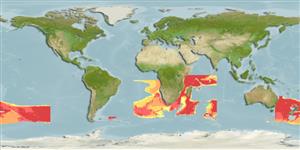>
Gadiformes (Cods) >
Macrouridae (Grenadiers or rattails)
Etymology: Coryphaenoides: Greek, koryphaina = dolphin fish + Suffix oides = similar to (Ref. 45335); grahami: Named for K. Graham..
More on authors: Iwamoto & Shcherbachev.
Environment: milieu / climate zone / depth range / distribution range
นิเวศวิทยา
เกี่ยวกับทะเล,น้ำเค็ม สัตว์ผิวน้ำในเขตน้ำลึก; ระดับความลึก 1034 - 1280 m (Ref. 11953). Deep-water
Southeast Atlantic: off South African west coast. Western Indian Ocean: Broken Ridge. Southwest Pacific: New South Wales.
ขนาด / น้ำหนัก / Age
Maturity: Lm ? range ? - ? cm
Max length : 40.0 cm TL เพศผู้/กระเทย; (Ref. 11953)
A benthic species found on the continental slope (Ref. 75154).
Life cycle and mating behavior
Maturities | การสืบพันธุ์ | Spawnings | Egg(s) | Fecundities | ตัวอ่อน
Iwamoto, T. and Y.N. Shcherbachev, 1991. Macrourid fishes of the subgenus Chalinura, genera Coryphaenoides, from the Indian Ocean. Proc. Calif. Acad. Sci. 47(7):207-233. (Ref. 10993)
IUCN Red List Status (Ref. 130435)
Threat to humans
Harmless
Human uses
เครื่องมือ
Special reports
Download XML
แหล่งที่มาจากอินเตอร์เน็ต
Estimates based on models
Preferred temperature (Ref.
123201): 2.9 - 5.7, mean 4.7 °C (based on 65 cells).
Phylogenetic diversity index (Ref.
82804): PD
50 = 0.5000 [Uniqueness, from 0.5 = low to 2.0 = high].
Bayesian length-weight: a=0.00575 (0.00195 - 0.01700), b=3.08 (2.83 - 3.33), in cm total length, based on LWR estimates for this (Sub)family-body shape (Ref.
93245).
ระดับชั้นอาหาร (Ref.
69278): 3.5 ±0.4 se; based on size and trophs of closest relatives
ความสามารถในการกลับคืนสู่ปกติ (Ref.
120179): ต่ำ, เวลาต่ำสุดที่จะทำให้ประชากรเพิ่มขึ้นเป็น 2 เท่าใช้เวลา 4.5 - 14 ปี (Preliminary K or Fecundity.).
Fishing Vulnerability (Ref.
59153): Low to moderate vulnerability (30 of 100).
